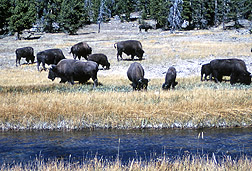TOP STORIES
Correction: The original news report, Scientists Counter Brucellosis Threat to Livestock and Wildlife, which appeared in the July 19 News Digest, was published on the USDA Agriculture Research Service (ARS) News & Events webpage on 7/15. On the following day, 7/16, the article introduction was amended as acknowledged by ARS.
“Agricultural Research Service realized after the story was posted that the location of the work was misstated in our original story, and that we have corrected the online version and regret the error.”Unfortunately, the News Digest, along with other media outlets, picked up and circulated the article prior to the text correction. See below for an excerpt and link to the amended article.
For more information on this topic, read the Yellowstone National Park news release from May 28, 2010, http://www.nps.gov/yell/parknews/10039.htm. In addition, a Draft Environmental Impact Statement (EIS) which looks at vaccinating bison against brucellosis can be found here for public comment.
Thank you,
The WDIN Team
 Scientists Counter Brucellosis Threat to Livestock and Wildlife
Scientists Counter Brucellosis Threat to Livestock and WildlifeArmed with dart guns and medical pellets, Agricultural Research Service (ARS) scientists are vaccinating bison at the ARS National Animal Disease Center (NADC) in Ames, Iowa, in support of Yellowstone National Park activities to combat brucellosis in bison.
The researchers are using a vaccine known as RB51. By vaccinating the bison, scientists hope to prevent the disease from spreading to livestock. Currently, no cattle herds in the U.S. are known to be infected, although some near Yellowstone have tested positive in the last decade, with elk being the suspected source.
U.S. Dept. of Agriculture, Agricultural Research Service - www.ars.usda.gov
15 July 2010 (Updated 16 July 2010)
C Guy
Photo courtesy of the National Park Service
15 July 2010 (Updated 16 July 2010)
C Guy
Photo courtesy of the National Park Service
 Hundreds of Dead Penguins Wash Up in Brazil
Hundreds of Dead Penguins Wash Up in BrazilHundreds of penguins that apparently starved to death are washing up on the beaches of Brazil, worrying scientists who are still investigating what's causing them to die.
About 500 of the black-and-white birds have been found just in the last 10 days on Peruibe, Praia Grande and Itanhaem beaches in Sao Paulo state, said Thiago do Nascimento, a biologist at the Peruibe Aquarium.
Most were Magellan penguins migrating north from Argentina, Chile and the Falkland Islands in search of food in warmer waters.
National Public Radio - www.npr.org [Source: Associated Press]
20 July 2010
Photo credit: Aquario Municipal de Peruibe
Location: Sao Paolo, Brazil - Peruibe - Map It , Praia Grande - Map It
, Praia Grande - Map It  , and Itanhaem - Map It
, and Itanhaem - Map It 
20 July 2010
Photo credit: Aquario Municipal de Peruibe
Location: Sao Paolo, Brazil - Peruibe - Map It
 , Praia Grande - Map It
, Praia Grande - Map It  , and Itanhaem - Map It
, and Itanhaem - Map It 
Reported number of bird deaths grow on Gulf Coast
The number of dead birds collected on the Gulf Coast has more than doubled in the past month as oil from BP's broken deepwater well continues to wash up on islands and beaches rich in bird colonies.
Officials say 2,599 dead birds had been collected on the Gulf Coast as of Thursday.
. . . The number of other dead animals being reported by officials has not climbed as steeply.
Google News - www.google.com/hostednews [Source: Associated Press]
22 July 2010
Location: United States - Map It
22 July 2010
Location: United States - Map It

More Gulf Oil Spill News
>>> Lack of dolphin deaths a marine mystery [includes video]
>>> Searching for the Gulf oil leak's victims [includes video]
>>> Lack of dolphin deaths a marine mystery [includes video]
>>> Searching for the Gulf oil leak's victims [includes video]
TOP READ LINKS FROM LAST WEEK
News
- Animal Autopsies in Gulf Yield a Mystery
- Prozac Pollution Making Shrimp Reckless
- Scientists Counter Brucellosis Threat to Livestock and Wildlife
- The Mississippi not a barrier to deer disease
- Scientists say fishing gear killed right whale found off Cape May
- Whither the Pangolin? Wildlife Smuggling Alive and Well in Asia
- Bison death toll up to 37 in anthrax outbreak
- "Miraculous" Fish Thrive Amid Jellyfish Swarm, Toxic Mud
- Dead carp washing up at Spokane-area lake
- ProMed: DIE-OFF, RIGHT WHALE
Publications
- Chronic wasting disease prions are not transmissible to transgenic mice over-expressing human prion protein
- The landscape genetics of infectious disease emergence and spread
- Surveillance for highly pathogenic avian influenza in wild birds in the USA
- Management of infectious wildlife diseases: bridging conventional and bioeconomic approaches
OTHER WILDLIFE HEALTH RELATED NEWS
- The week in wildlife [image gallery]
- Shutting down the batcave [White-nose syndrome]
- Satellites tracking loons in Wisconsin and Minnesota [U.S. Geological Survey; video]
- Lake closed after algae outbreak [Taplow Lake, Buckinghamshire, UK]
- British seas: More fish, cleaner and greater biodiversity, says Defra
- Poisoning of Scottish birds of prey at highest levels in 20 years
- Frog Killer Caught in the Act: Incidence of a lethal infectious disease moves at a rate of 30 kilometers per year
- Should Smuggled Madagascar Frogs Be Returned Home?
Photo credit: Arpat Ozgul
 Climate Change Causes Larger, More Plentiful Marmots, Study Shows; Implications for Many Creatures That Hibernate
Climate Change Causes Larger, More Plentiful Marmots, Study Shows; Implications for Many Creatures That Hibernate- Coral reefs doomed by climate change




